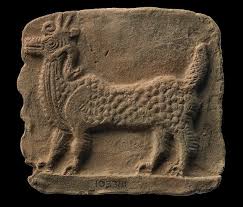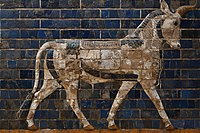lataus (5) jpg
(8.81 KB, 243x207)
"he seams were then sealed with a naturally occurring black viscous substance called bitumen, like modern asphalt."
"The Pitch Lake is the largest natural deposit of asphalt in the world, estimated to contain 10 million tons. It is located in La Brea in southwest Trinidad"
"The expression "bitumen" originated in the Sanskrit words jatu, meaning "pitch", and jatu-krit, meaning "pitch creating" or "pitch producing" (referring to coniferous or resinous trees). The Latin equivalent is claimed by some to be originally gwitu-men (pertaining to pitch), and by others, pixtumens (exuding or bubbling pitch), which was subsequently shortened to bitumen, thence passing via French into English. From the same root is derived the Anglo-Saxon word cwidu (mastix), the German word Kitt (cement or mastic) and the old Norse word kvada"
"Once per year, the Ishtar Gate and connecting Processional Way were used for a New Year's procession, which was part of a religious festival celebrating the beginning of the agricultural year. In Babylon, the rituals surrounding this holiday lasted twelve days. The New Year's celebrations started immediately after the barley harvest, at the time of the vernal equinox. This was the first day of the ancient month of Nisan, equivalent to today's date of March 20 or 21."
"was designed with brick relief images of lions, the symbol of the goddess Ishtar (also known as Inanna) the war goddess, the dragon of Marduk, the lord of the gods, and the bull of Adad, the storm god. Worshipped as the Mistress of Heaven, Ishtar represented the power of sexual attraction and was thought to be savage and determined. Symbolized by the star and her sacred animal, the lion, she was also the goddess of war and the protector of ruling dynasties and their armies."
"Each lion was made of forty-six molded bricks in eleven rows...The purpose of the New Year's holiday was to affirm the supremacy of Marduk and his representative on Earth, the king, and to offer thanks for the fertility of the land.
The Processional Way was paved with large stone pieces set in a bed of bitumen and was up to 66 feet wide at some points. This street ran from the Euphrates through the temple district and palaces and onto the Ishtar Gate."
"A reconstruction of the Ishtar Gate and Processional Way was built at the Pergamon Museum in Berlin out of material excavated by Robert Koldewey...Only four museums acquired dragons, while lions went to several museums. The Istanbul Archaeology Museum has lions, dragons, and bulls. Ny Carlsberg Glyptotek in Copenhagen, Denmark, has one lion, one dragon and one bull. The Detroit Institute of Arts houses a dragon. The Röhsska Museum in Gothenburg, Sweden, has one dragon and one lion; the Louvre, the State Museum of Egyptian Art in Munich, the Kunsthistorisches Museum in Vienna, the Royal Ontario Museum in Toronto, the Metropolitan Museum of Art in New York, the Oriental Institute in Chicago, the Rhode Island School of Design Museum, the Museum of Fine Arts in Boston, and the Yale University Art Gallery in New Haven, Connecticut, each have lions. One of the processional lions was recently loaned by Berlin's Vorderasiatisches Museum to the British Museum."
https://en.wikipedia.org/wiki/Marduk
"God of Babylon,God of creation, water, vegetation, judgment, and magic" "Marduk is associated with the divine weapon Imhullu. His symbolic animal and servant, whom Marduk once vanquished, is the dragon Mušḫuššu. "Marduk" is the Babylonian form of his name...Marduk had become astrologically associated with the planet Jupiter...Marduk's original character is obscure"
and in entertainment it's said "An Obscurial is a young wizard or witch who developed a dark parasitical magical force, known as an Obscurus, as a result of their magic being suppressed through psychological or physical abuse." guess which film?


